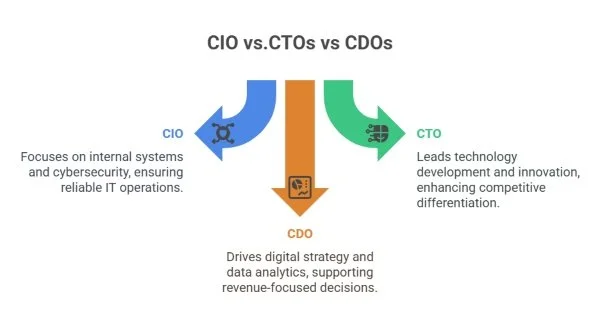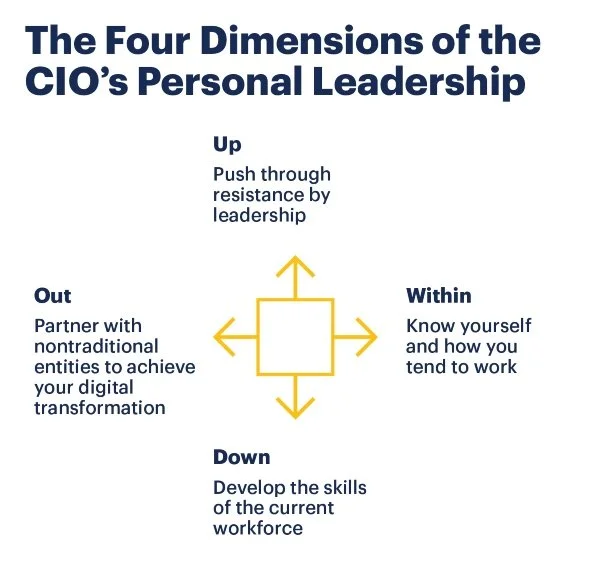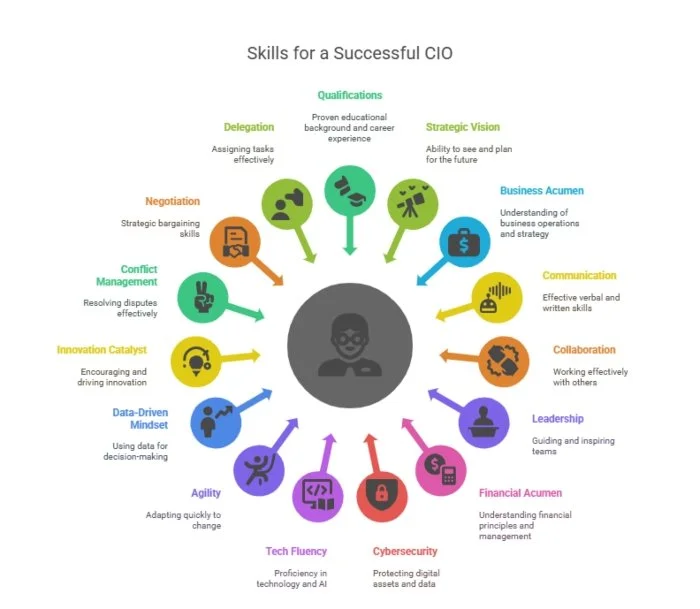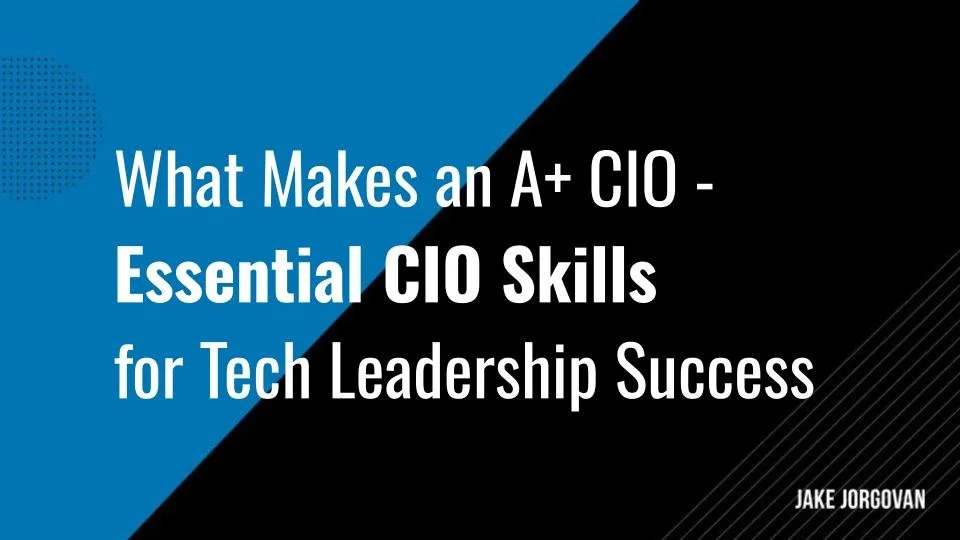What Makes an A+ CIO: 15 Key CIO Skills for Tech Leadership Success
The CIO role has evolved from managing infrastructure to shaping business strategy.
Today, it’s about driving growth, enabling speed, and embedding risk management into every strategic decision.
In fact, 77% of global executives say CIOs are essential for business transformation. That tells you everything you need to know about how this role has shifted.
Hiring a CIO means putting real weight behind strategic execution. You need someone who drives momentum, clears bottlenecks, and accelerates smart decisions. If that’s not happening, you’ve got friction at the top.
In this blog, we’ll break down the essential skills that separate high-impact CIOs from the rest. Let’s take a look.
TL;DR:
The best CIOs deliver on these fronts:
Strategic vision: Sees where the business is going, and aligns tech to get there.
Business acumen: Ties IT spend to revenue, risk, and market opportunity.
Effective communication: Turns complexity into clarity and builds buy-in fast.
Cross-functional collaboration: Connects dots across teams, not just inside IT.
Change leadership: Keeps momentum during disruption, not confusion.
Financial savvy: Trims fat, defends budgets, and speaks the CFO’s language.
Cybersecurity focus: Treats risk like strategy, not an afterthought.
Tech fluency: Filters vendor noise and leads on AI, automation, and infrastructure.
Adaptability: Responds fast to shifting priorities, tools, and threats.
Data-driven mindset: Builds technology systems that power better, faster decisions.
Innovation drive: Moves bold ideas into MVPs and real outcomes.
Strong foundations: Knows the ops because they’ve run the ops.
Conflict navigation: Bridges gaps between IT, business, and leadership.
Strategic negotiation: Manages politics, priorities, and external partners.
Delegation: Builds strong deputies and scales by letting go.
What is a CIO (and why does it matter more than ever)?
A Chief Information Officer (CIO) leads the technology function that powers business performance. The role covers core infrastructure and systems as well as the strategic alignment of technology with broader organizational goals.
CIOs translate broader business objectives into actionable tech infrastructure. They make sure your systems support smarter decisions, faster workflows, and secure growth.
The position has evolved far beyond traditional IT oversight. Today’s CIO collaborates across departments, manages substantial budgets, and reports directly to the CEO or board, positioning technology as a central pillar of competitive advantage.
What Does a Modern CIO Actually Do?
A modern CIO oversees a broad set of responsibilities that span infrastructure, strategy, and execution. Key areas of ownership include:
IT strategy and architecture: Designing infrastructure that supports growth, security, and speed.
Cybersecurity oversight: Leading risk discussions and breach readiness, not just compliance.
Data systems and governance: Making sure reporting is accurate, accessible, and driving decisions.
AI and automation adoption: Evaluating tools, aligning them with workflows, and preventing shadow IT.
Cross-functional integration: Connecting sales, ops, HR, and finance through shared platforms.
Tech vendor management: Negotiating contracts, evaluating pricing, and holding partners accountable.
Budget planning: Balancing cost control with the need for innovation and agility.
Ultimately, the CIO is responsible for linking every technology decision to measurable business outcomes. If a new initiative doesn’t improve margins, accelerate delivery, or reduce churn, it fails to meet the mark.
Pro Tip: Not every company needs a full-time CIO. Some go with flexible models, depending on their size, stage, and priorities. If you’re not sure which one fits your org, this fractional CIO vs. in-house CIO comparison breaks down the trade-offs.
How the CIO Role Has Evolved Over the Last Decade?
Old-school CIOs were order-takers. The job was to manage internal tickets and make sure nothing broke.
Today? The job is to accelerate strategy. Now, 61% of CIOs own business strategy, while 67% of them sit on executive boards.
Why the shift? Because infrastructure now affects everything: how fast teams work, how fast customers convert, how well companies scale.
If your tech isn’t driving business outcomes, your competitors’ tech probably is.
How CIOs Compare to CTOs and CDOs?
Although these roles are sometimes used interchangeably, each serves a distinct function within a modern digital enterprise.
CIO (Chief Information Officer): Focuses on internal systems, infrastructure, cybersecurity, and IT service delivery. The CIO ensures technology operations align with business needs and run reliably at scale.
CTO (Chief Technology Officer): Leads technology development with a focus on external innovation. The CTO oversees product engineering, tech stacks, and customer-facing platforms, prioritizing speed, scalability, and competitive differentiation.
CDO (Chief Digital Officer): Drives digital strategy through data, analytics, and transformation initiatives. The CDO is responsible for converting data into actionable insight, modernizing digital channels, and supporting revenue-focused decision-making.
In early-stage companies, a single leader often takes on the responsibilities of CIO, CTO, and CDO. But as the organization scales, a dedicated CIO becomes essential, someone who can cut through operational noise, align technology with business strategy, and lead execution with a focus on impact.
That’s the difference between shipping features and delivering sustainable growth.
The Four Faces of the CIO
There’s no single version of a modern CIO. But some models do a solid job of mapping how they operate.
A widely known model is Deloitte’s framework, which defines four “faces” of a CIO. Each one reflects a mindset and set of responsibilities that show up at different moments in the job:
The strategist: Aligns IT with long-term goals. They help tech drive sustainable growth, reduce risk, and support expansion, not just react to needs.
The catalyst: Drives enterprise-wide transformation. These CIOs reimagine processes, optimize structures, and lead the organization through strategic change.
The technologist: Makes foundational decisions about platforms, systems, and architecture, ensuring flexibility, scalability, and security.
The operator: Oversees delivery and execution. This includes uptime, service quality, team performance, and operational accountability.
Each of these roles requires a different type of thinking. And a smart CIO knows when to switch between them.
But Deloitte’s not the only one with a model that works.
Gartner breaks it down differently: not by function, but by influence. Their “Four Leadership Dimensions of the CIO’s Personal Leadership” model goes deep into how CIOs move the business forward: up, down, across, and within.
Source: Gartner
Lead up: Work with senior execs. Address resistance, speak clearly about digital priorities, and bring credibility to the table.
Lead down: Invest in team development. Build learning into performance metrics and empower managers to elevate their people.
Lead across: Create partnerships that speed up execution. Often outside of IT (startups, fintechs, vendors), where fresh thinking lives.
Lead within: Communicate with clarity. Tailor messages to every room. Use storytelling to connect strategy to outcomes.
Both models agree on one point: CIOs need range. Functional depth is great. But without influence, nothing moves.
Why the CIO Role is Business-Critical in Modern Companies?
CIOs now sit at the center of every function that drives business speed and stability. When the CIO operates too far down the org chart, execution suffers. This role is essential to:
Enabling timely product launches
Delivering clean, reliable data for M&A due diligence
Simplifying compliance before audits
Aligning technology initiatives with revenue-generating priorities
An effective CIO designs systems that scale, integrate seamlessly, and support autonomous execution. This means no friction and costly handoffs.
They’re also the firewall between tech debt and operational risk. While others look at new tools or platforms, CIOs see dependencies, exposure, and what breaks under pressure.
Tech can either accelerate your team or hold it back. A CIO who understands how to balance both is no longer optional.
Pro tip: High-performing CIOs don’t respond to generic offers. If you’re serious about bringing one in, check out how to attract a top-tier CIO to your organization.
What Happens When the CIO is Missing (or misaligned)?
When the CIO role is weak (or worse, nonexistent), things break. Not in obvious ways at first. But the symptoms show up fast:
Technical debt piles up.
Vendors run the roadmap.
Systems don’t scale.
Security gaps widen.
Projects stall mid-flight because IT was brought in too late.
A “Head of IT” who handles tickets and keeps the lights on isn’t a replacement for executive leadership. Without a CIO who understands the business, IT becomes reactive. And that slows everything else down.
Alignment matters. The best CIOs sit at the executive table, shape strategic goals, and connect digital execution to what actually moves the needle.
When that’s missing, friction grows. Teams build workarounds. Data gets siloed. Decisions drag. And suddenly, your tech stack becomes more of a tax than a tool.
Pro Tip: Workarounds and shadow IT aren’t innovation. They are signs you’re missing strategic leadership at the top.
Industry Data that Proves the Strategic Value of the CIO
Let’s look at what the numbers say:
CIOs are at the forefront of AI adoption, with 80% overseeing the research and evaluation of AI tools within their organizations.
Approximately 59% of CIOs say their role now has a greater influence on their company’s revenue generation.
As reported by Foundry, 82% of CIOs are more involved in leading digital transformation initiatives compared to their business counterparts.
That report also found that 50% of CIOs identify as business leaders who actively influence technology decisions to achieve strategic goals. The rest take on roles such as consultants (21%), risk assessors (13%), supporting contributors (11%), or objective advisors (5%).
86% of AI-forward companies have CIOs leading or co-leading GenAI initiatives alongside business units.
85% of CIOs are focused on strengthening security, and 70% emphasize the importance of data-driven decision-making.
The numbers don’t lie: CIOs are now driving the systems, the culture, and the strategy behind real business performance.
What Qualities are Essential for a Successful CIO? Top 15 Must-Have Skills
So, what sets great CIOs apart from the rest? Let’s explore the must-have qualities every successful CIO brings to the table.
P.S.: Before we begin, keep in mind that knowing what to look for isn’t enough. This guide on how to vet and interview your next CIO shows real ways to test for the blend of skills that matter.
1. Proven Qualifications and Career Foundations
Strong CIOs don’t walk into the role unprepared.
They’ve been tested: leading IT transformations, solving inherited messes, and shipping digital products under pressure. They know what it takes to execute because they’ve done the hard work.
Credentials help, but only when backed by execution. The best CIOs pursue certifications with purpose. PMP strengthens delivery. CISSP signals security fluency. Cloud certifications show they’re keeping pace with change.
As outlined by the University of San Diego, top certifications for IT leadership roles also include PMI-ACP, Certified ScrumMaster (CSM), ITIL, and CGEIT. The value here comes from knowing how to apply them when business is on the line.
Also, what really sets them apart is perspective. CIOs with cross-domain experience make smarter calls because they see the ripple effects. Technical fluency is essential, but strategic context multiplies its value.
And that brings us here:
“A digital CIO has to be a digital visionary, a transformational leader; an empathetic communicator; a good facilitator, a great listener, and an excellent digital game changer.” Pearl Zhu, Author of 12 CIO Personas.
2. Strategic Vision
CIOs with vision shape direction, not just execution. They read beyond quarterly goals, connect business strategy with tech capabilities, and prioritize what creates real momentum, not noise.
This isn’t about blue-sky thinking. Strategic vision is evident in how priorities are set, tough calls are made, and the organization stays aligned when the market shifts.
Troy Hiltbrand, CIO and IT strategy expert, captured it well:
“It requires that the CIO lift themselves from the limitations related to the current operational work and envision what could be, assuming that many of the day-to-day challenges were resolved.”
3. Business Acumen
Strong CIOs think in margins, market share, and customer value instead of just system uptime.
They tie every tech decision to a business result: higher revenue, better retention, smoother ops. And they don’t speak in code. Instead, they speak the language of the C-suite executives.
Tech has to serve a strategic purpose. The best CIOs zoom out to connect systems, people, and outcomes across the entire business.
4. Effective Communication
CIOs operate at the intersection of technology and every critical aspect of business operations. Their role depends on the ability to convey technical concepts with clarity, aligning cross-functional teams, and keeping strategic goals on track.
Communication goes beyond simplifying technical language. It involves adapting the message to the audience, whether addressing engineers in sprint reviews or presenting to the board, while consistently reinforcing how technology supports business outcomes.
As Arthur Hu, SVP and Global CIO at Lenovo, explains:
“Communicating effectively is more important than ever. (...) CIOs can facilitate communication across the enterprise. They are uniquely positioned to see the bigger picture across the entire organization, transcending departmental silos.”
CIOs who master this can shape understanding, remove roadblocks, and unite teams around a shared vision.
5. Collaboration and Partnership
No CIO operates in a vacuum. The strongest ones know that real transformation happens when every department moves in sync.
They work side by side with CMOs to connect data with customer impact. With COOs, they tighten up operations. And with HR, they plan for tomorrow’s tech talent before it becomes today’s gap.
That kind of alignment takes more than status updates. As Ryan Smith, CIO at Intermountain Healthcare, puts it:
“Start with a really crystal-clear understanding of what’s not working by putting yourself into the shoes of your business partners.”
When CIOs lead like this, they build systems that move the business forward.
6. Leadership and Change Enablement
CIOs don’t just react to change; instead, they shape how the organization responds.
They build resilient teams, guide people through uncertainty, and lead cultural shifts that drive real progress. During digital transformation, the real challenge goes beyond choosing a platform; it's about helping people embrace it, use it effectively, and understand its purpose.
This kind of leadership goes beyond managing tasks. It’s about setting direction, being effective communicators, and modeling how to navigate complex situations. It’s where strategic thinking meets people-first execution, because none of the tech matters if the team can’t move with it.
Or, as Randy Mott, CIO of General Motors, puts it: Being a CIO is more than leading IT; it’s about pioneering the paths that no one else has ventured.
7. Financial Acumen
A great CIO moves money like a strategist. Every tech decision has financial weight, and smart CIOs treat spending as a lever to drive outcomes.
They know when to push CapEx, when to lean into OpEx, and how to map tech spend directly to business growth.
That means speaking fluently with the CFO and understanding changing goals after an acquisition. Also, means balancing short-term savings with long-term wins and knowing exactly how to defend technology investments in front of a skeptical board.
As Amit Sinha explains, the goal is to focus on the outcomes that actually move the needle. Especially in the moments that matter most:
“Imagine a CIO who has three specific ways they can reduce IT expenditures or increase productivity. Perhaps exercising options A and B will save their organization the most money. Yet, options B and C save less money while greatly improving other outcomes. The optimal decision depends heavily upon which metrics the company is trying to achieve. Understanding this larger picture is key, and it requires a continuous effort.” Amit Sinha, former president of Zscaler (per Zscaler)
8. Cybersecurity Ownership
Security is no longer a side concern; it’s baked into every decision a CIO makes.
From ransomware to AI-driven threats, the attack surface keeps expanding, and the pressure to protect it keeps rising. CIOs are expected to handle that pressure without slowing the business down.
That means going beyond technical fixes. Strong CIOs work closely with CISOs, shape executive discussions, and frame risk in ways the board can act on.
Gaurav Kumar Singh reinforces the urgency:
“Right now, the best CIOs need to be very knowledgeable about cybersecurity and AI. Advancements in generative AI have introduced new vulnerabilities that cybercriminals can exploit to launch automated and sophisticated cyberattacks. CIOs must collaborate with cybersecurity teams, implement robust AI security protocols, and prioritize employee awareness training to securely combat AI-powered threats.” Gaurav Kumar Singh, founder of Guddi Growth, as quoted in Forbes’
9. Tech Fluency and AI Readiness
CIOs aren’t expected to be engineers. But they do need a sharp grasp of how systems function, from infrastructure to integration.
As AI becomes part of the tech foundation, understanding how it interacts with platforms, workflows, and data is no longer optional.
This fluency helps CIOs cut through hype, evaluate tools confidently, and lead technology adoption intently. Without it, they risk slowing progress or falling for surface-level solutions. With it, they become strategic guides in the fast-moving technology landscape.
10. Agility and Adaptability
Markets shift. Tech evolves. Strategies get rewritten. CIOs need to respond fast, without losing focus or momentum. Adaptable leaders keep execution moving, even when priorities change mid-quarter or new risks pop up overnight.
Agility does not mean chasing trends. It requires purposeful adjustment, reframing roadmaps, reallocating resources, and keeping teams aligned with measurable outcomes, regardless of volatility.
As Michael Carlin, CIO at AbbVie, put it:
“The pace of change is so quick, the winners are going to be the ones that can understand that and adapt the most quickly.”
11. Data-Driven Mindset
CIOs can’t afford to rely on gut instinct anymore. Real-time, accurate data is the new standard for decision-making.
In fact, 90% of executives agree that data-driven decisions are critical to modern business success.
That kind of clarity doesn’t happen by accident. Great CIOs design systems that surface the right signals at the right time. They champion data literacy across teams, invest in analytics tools, and foster a culture where insight leads to action, not just observation.
Beyond collecting dashboards, what matters is making sure their actionable insights reach the right hands, shape strategic direction, and drive faster, better outcomes across the business.
12. Innovation Catalyst
Great CIOs don’t just manage tech; they help shape what’s next. From piloting AI initiatives to co-building internal labs, they create motion around innovation, not just momentum.
But it goes beyond chasing the latest shiny tool. What matters here is building repeatable processes that turn smart ideas into scalable and innovative solutions. The best CIOs carve out space for experimentation while making it clear that innovation is everyone’s job.
13. Conflict Navigation
CIOs operate between competing demands: speed from marketing, control from security, predictability from finance, and autonomy from engineering.
The tension is part of the job. And what separates strong CIOs is their ability to lead through that friction.
They know how to keep conversations moving, even when agendas clash. That includes defusing polarized debates, translating between technical and non-technical teams, and holding alignment when stakes are high.
Not everyone gets this right. Only 33% of above-average CIOs (and just 10% of those performing below expectations) are considered effective at managing conflict.
This skill divides lines between average and high-performing leadership. It’s not optional.
14. Strategic Negotiation
Every CIO negotiates. It’s part of the job: contracts, timelines, roadmaps, and budgets. But negotiation is a powerful skill that defines how IT shows up at the executive table.
Top CIOs create leverage instead of waiting for it. They build trust early, stay outcome-focused, and know when to hold firm.
They focus on the negotiations that move the business forward. The goal is clear: ensuring execution stays tied to real priorities.
Christie Struckman, VP analyst at Gartner, says it best:
“To be a successful negotiator, CIOs must cultivate relationships and influence among C-level executives and vendor leadership, before they are needed, and tap them at the right time to produce results in low-leverage situations.”
15. Delegation
CIOs who try to control everything end up slowing everyone down.
The best CIOs know where they’re needed and when to step back. They give their teams room to operate, take ownership, and make the right calls without constant oversight. That kind of trust builds speed, clarity, and accountability across the board.
It also opens up space for leadership to grow. As Cisco Sanchez, SVP and CIO at Qualcomm, points out:
“...delegating more decision-making authority gives potential leaders in the organization an opportunity to demonstrate their abilities and rise up in the ranks. When you release control, you get more back.”
Done right, delegation becomes a force multiplier, not a risk.
Bottom line: Great CIOs change everything
A strong CIO does more than manage systems. The right hire will shape how the business competes, adapts, and grows. Also, it will bring clarity in chaos, drive meaningful change, and earn influence where it counts.
If you're building out your leadership team and tech is central to your strategy, this isn't a role to take lightly. Use the skills above to guide your search, filter out surface-level candidates, and zero in on the kind of leadership that delivers under pressure.
Looking for expert help with the search? Check out these top CIO and IT executive search firms leading the way in hiring strategic tech leaders.
Frequently Asked Questions
What are the three most important traits of a CIO?
Strategic thinking, communication skills, and adaptability. A CIO must see where the business is going and align tech to that future. They also need to communicate that vision across departments and translate complex ideas into actionable plans. And when conditions shift, they have to shift with them.
What skills do you need to be a CIO?
You need a blend of technical acumen, leadership, financial literacy, and business acumen. CIOs bridge tech and business. They understand infrastructure, cloud solutions, AI, and cybersecurity, but they also lead teams, manage budgets, and know how their work impacts growth, revenue, and efficiency.
How to be a successful CIO?
Start by being obsessed with outcomes, not just systems. Work closely with stakeholders, ask hard questions, push for clarity, and don’t get buried in tech for tech’s sake. Measure impact. Champion change. Build trust.
Success as a CIO comes from aligning your department with company goals and the most urgent priorities.
What is the best leadership style for a CIO?
The most effective CIOs lead with collaboration and clear direction. They’re not micromanagers. They trust their teams, set measurable goals, and create space for innovation. But they also hold people accountable and know when to say no.
Does a CIO need to be technical?
Yes, A CIO needs technical skills. But not in the way a software engineer has, CIOs don’t need to code daily, but they must understand the technology architecture, risks, and possibilities of the systems they’re overseeing. Without that knowledge, it’s hard to lead or challenge your teams effectively.
What are the priorities of a CIO?
Protect the business, improve performance, and prepare for what’s next. That means staying ahead of cybersecurity risks, eliminating inefficiencies, aligning IT with business goals, and identifying new opportunities before competitors do.
What does a CIO do on a daily basis?
They make strategic decisions that affect the entire organization. That includes meeting with stakeholders, reviewing key metrics, solving operational roadblocks, supporting their teams, and staying on top of emerging technology trends.
























